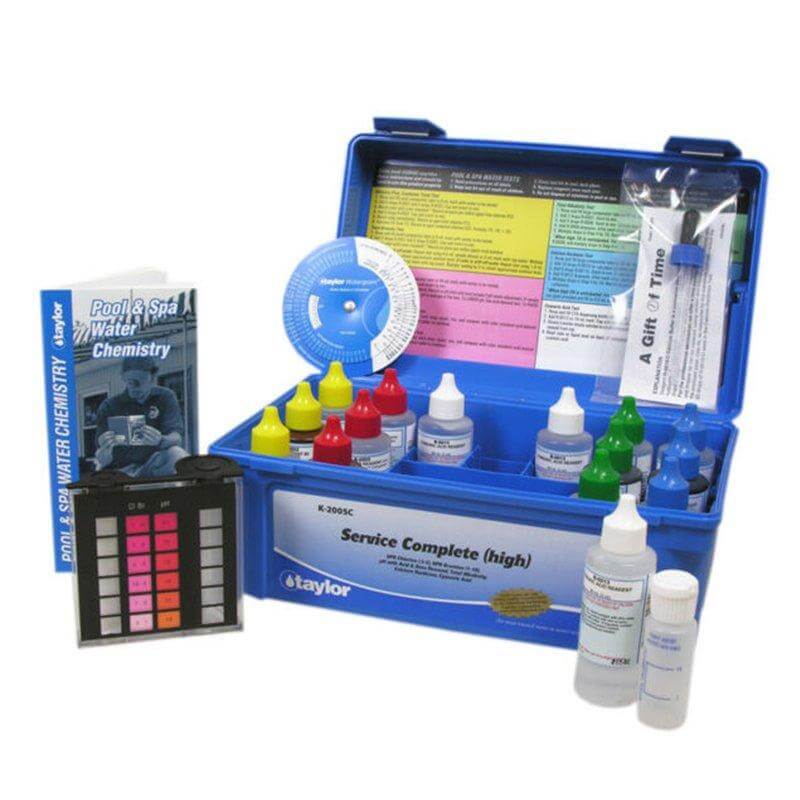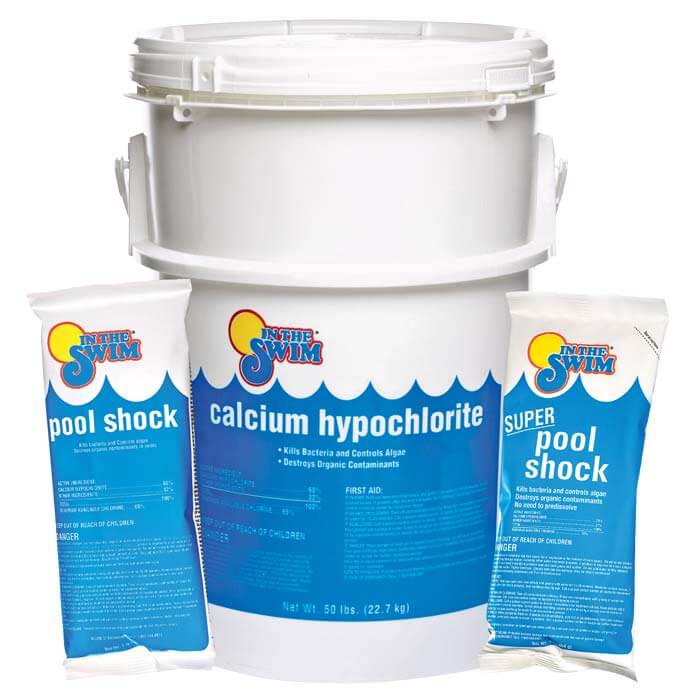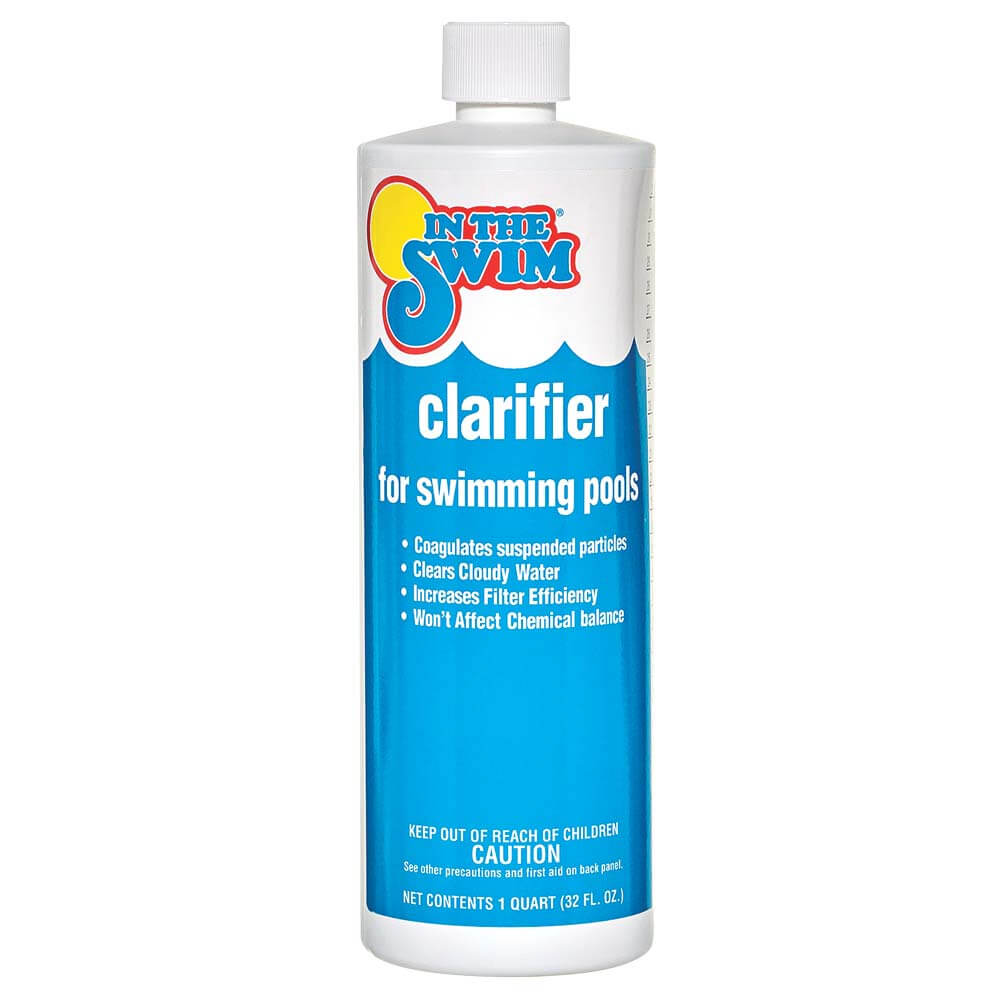FREE Standard Shipping On All Orders $100 or More!*
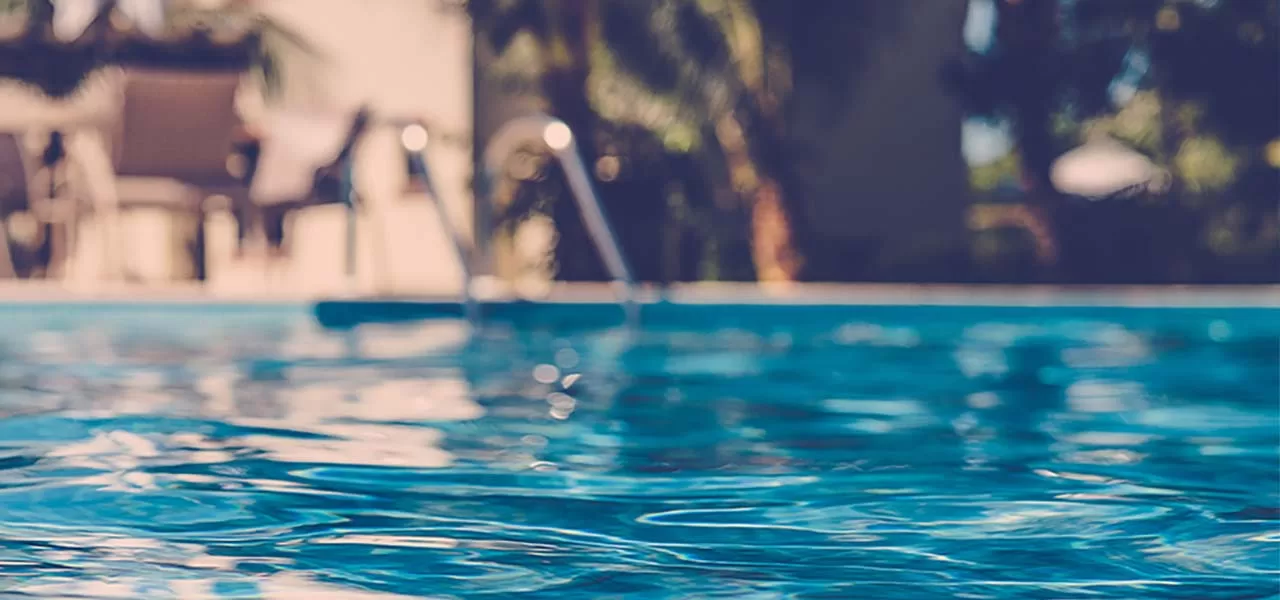
Cloudy Pool Water Issues
As a former pool store manager for over a decade, you can trust that I’ve heard my fair share of, “My pool water’s cloudy, what can I do?!” In fact, it was the number one issue, day in and day out. It was my job to figure out what was causing the cloudy pool water and how to fix it.

What Causes Cloudy Pool Water?
Unfortunately, there are a number of reasons why pool water goes turbid. Truthfully, it’s not uncommon to find the water a little hazy when first opening the pool each spring. It will sometimes pop up again during swimming season if conditions aren’t right. Water chemistry, circulation, and filtration are the most common culprits when it comes to cloudy pool water problems.
But one thing is for certain – when your pool turns cloudy or milky blue, you need to find the source of the problem and fix it right away. Cloudy water is just one visible symptom for a number of problems in the pool.
Low Sanitizer Levels

Have you ever noticed that if you forget to put chlorine tabs in the pool, it begins to turn hazy before it goes green? Without a constant supply of sanitizer, particulate matter accumulates and becomes visible, sometimes within hours!
There are three forms of chlorine measured in a pool: Free Available Chlorine (FAC), Total Available Chlorine (TAC), and Combined Chlorine (chloramines). Free Available Chlorine is the one that actually does the sanitizing; it’s free and available to fight off germs and algae in the water.
Ideally, your FAC and TAC levels should be the same, and both should be in the 2.0-4.0 ppm range for most pools. When TAC is at least 0.3 ppm higher than FAC, it means your pool has too much inactive Combined Chlorine (chloramine) in it. Break down those chloramines with a shock treatment. Pool shock can also be used to raise chlorine levels that are too low. If TAC is above 2.0 ppm, use a non-chlorine pool shock. If it’s under 2.0 ppm, use chlorinated shock.
Poor Water Balance
If any aspects of water balance move to the high end of the scale, you’re setting yourself up for a battle with cloudy pool water. Not only can unbalanced pool water lead to cloudy conditions, but it can cause problems with sanitation, as well. Keep your water within these recommended ranges:
- Total Alkalinity: 80-120 ppm Ideal (60-180 ppm Acceptable)
- pH: 7.4-7.6 Ideal (7.2-7.8 Acceptable)
- Calcium Hardness: 200-400 ppm Ideal (150-800 ppm Acceptable)
- Cyanuric Acid: 30-50 ppm Ideal (10 ppm Minimum)
- Total Dissolved Solids: 0-2500 ppm Ideal for Non-Salt Water Pools
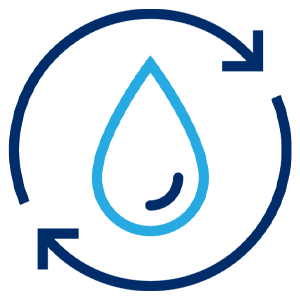
Inadequate Circulation
Your pump and filter can only do so much to turn over all of the water in your pool. If your pump can’t work efficiently, or if your return eyeballs aren’t arranged to increase circulation in the pool, you’ll constantly be struggling to keep the water clear.
Keep skimmer and pump baskets free of debris. Ensure that there are no clogs or leaks in pool plumbing or equipment. Run the pump for 8-10 hours a day (more for variable speed pumps) or longer in hot weather. Brushing the pool, using an automatic pool cleaner, and even just using the pool will boost circulation and help move water around the pool more efficiently.
Inefficient Filtration
A filter that’s not sized correctly for a pool won’t be able to work efficiently. But even if your filter is the right size, old or damaged filter media (sand, filter cartridges, and DE grids) will allow fine debris particles to move right on through and return to the pool. As you can imagine, this is problematic when you’re trying to clear up increasingly cloudy pool water! Pump issues and air leaks can also impact filtration ability.
High Levels of Contamination

A high bather load, animals in the pool, and stormy weather can all bring high levels of contaminants into the water. When this happens, it's hard for your filter to keep up. Bather waste, such as sweat, body oils, lotions, and cosmetics, will quickly overwhelm and gum up your pool filter. This is why it's so important for swimmers to take a shower before entering the water! Add in the amount of pollen, dirt, hair, organic debris, and other pollution brought in by wind, rain, and water-loving pets, and you have quite a mess on your hands! Another source of high water contamination is a layer of fresh plaster. Fresh plaster can “dust up” for the first 6-12 months after it’s applied.
Other Causes
There are a few other ways pools can cloud up. Some are even caused by pool owners themselves during chemical applications. For example, cloudy water after shocking the pool is actually a pretty common occurrence. It’s usually just a temporary reaction, as the sanitizer works its magic, and doesn’t always indicate a problem.
But if the cloudy water persists long after you’ve shocked the pool, you're likely having an issue with water balance, circulation, or filtration. Heavy use of a calcium based pool shock (cal-hypo) may increase Calcium Hardness over a period of time, increasing your odds of cloudy water. Other chemical application errors have been known to cloud a pool. For example, adding more than one chemical to the water at a time or using chlorine products in a biguanide pool will cause adverse reactions.
Can You Swim in Cloudy Water?
It depends. If the water is so cloudy that you can’t easily see the bottom of the pool, nobody should be swimming in it, let alone diving into it. Severely clouded water poses an increased risk of severe injury or drowning because of the lack of visibility and depth perception. But even if the water is only slightly cloudy, it’s still not a good idea to go swimming until you understand what’s causing it. Cloudy water can harbor all sorts of germs and waterborne pathogens.
How to Prevent Cloudy Pool Water

If you want to avoid cloudy water in the first place, it really just boils down to properly maintaining your pool:
- Test the water at least two or three times a week to ensure healthy water chemistry.
- Keep Free Available Chlorine, Total Alkalinity, pH, Calcium Hardness, and Cyanuric Acid levels in the proper ranges.
- Shock the pool once a week to keep your sanitizer working efficiently, oxidize contaminants, and ensure adequate chlorine levels.
- Run the pool pump long enough to filter all of the water in the pool at least once a day, and don’t forget to keep your pool filter clean.
- Encourage swimmers to shower before entering the water, to avoid overwhelming your filter and sanitizer with body oils, cosmetics, lotions, deodorants, and other contaminants. This is especially true if your pool has a heavy bather load or gets used frequently.
How to Fix Cloudy Pool Water
Even under the best circumstances, cloudy pool water can still pop up from time to time. If your pool water looks hazy and turbid, follow these steps to make it crystal clear again.
- Clean the pool thoroughly to remove all organic debris. Clean out pump and skimmer baskets, skim the surface, vacuum the floor, and thoroughly brush all pool surfaces (floor, walls, steps, waterline, etc.).
- Test and balance the pool water. If your at-home test kit is old or untrustworthy, take a sample to your local pool store for more accurate professional testing. Some stores even offer free water tests!
- Shock the pool according to label instructions.
- Run the pump 24/7 until the water clears up. If your filter’s pressure gauge is 8-10 PSI higher than the starting “clean” pressure reading, clean the filter.
- Use either a clarifier or flocculant, which will coagulate the small particles your filter missed into much larger clusters. Clarifier helps your filter work more efficiently to remove those particles as they pass through. It’s ideal for mild to moderate cloudiness, and can be used as a preventative measure during regular maintenance. Flocculant drops the suspended particles to the floor, where they must be vacuumed to waste. Pool floc is great for extreme cloudy water conditions, and it works much more quickly than a clarifier. However, the pool floc method is more time intensive, you’ll have to replace lost pool water, and it’s not usually a viable option if you have a cartridge pool filter (unless you have a filter bypass valve).
Bonus tip! If you have a robotic pool cleaner, use it to help clear your cloudy water. Most robotic cleaners can filter particles as small as 3 microns. In some cases, they may even be more efficient than your regular pool filter. But even if you don't have a robotic cleaner, any automatic cleaner will at least increase circulation throughout the pool and help clear the water faster.
When Cloudy Pool Water Won't Clear Up…
Stubborn cloudy water issues are a pain! If you’ve followed the steps above and your water still has a hazy appearance, there are a few more things you can check.
As we mentioned earlier, take a good, hard look at your pool filter. Does it need new filter media? Age and consistent use eventually take their toll, and your filter loses its ability to capture smaller particles as the media wears out. Also consider if the filter is sized properly to accommodate your pool and support the flow rate of your pool pump.
If your filter pressure is lower than normal, there may be a clog in the pump impeller, pump/skimmer baskets, or elsewhere in your plumbing system. Another possibility is a faulty backwash valve. Check to see if there’s any air entering the system, and either refill the pool to proper levels or address air leaks as needed.
Check that your pump is operating correctly. Make sure the motor is not overheating and cycling on and off. If the pump isn’t circulating for long enough each day, your filter can’t do much to help clear your pool water.
A Quick Note on the Langelier Saturation Index
Developed in the 1930’s, the Langelier Saturation Index is a handy way to calculate your pool water’s propensity to scale, or precipitate calcium and other mineral salts. Negative results indicate a corrosive water propensity. The formula can be used to determine if the water is dissolving, precipitating, or in equilibrium.
The formula is: pH + AF + CF + TF – 12.1
AF = Alkalinity Factor
CF = Calcium Factor
TF = Temperature Factor
How do you find the "factor?" Refer to the chart below to find the appropriate number based on conditions in your pool:
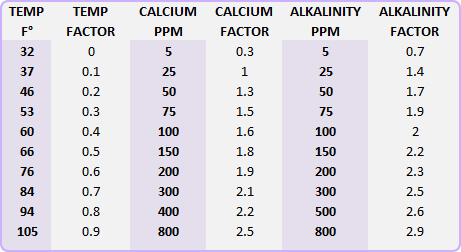
A pool in perfect equilibrium has a result of 0.0 – yet anything from -0.3 to +0.3 is acceptable, and considered to be neither scaling nor corrosive.
Performing a saturation index calculation can help you see how to adjust your water balance to avoid scaling water conditions, which lead to cloudy pool water. Pentair has a nice Saturation Index calculator on their website, if you’d rather not do the math!
The Index incorporates water temperature into the calculation, which plays an important role in water clarity. Ideal pool water balance fluctuates from spring to summer to autumn, because of the effect of water temperature on dissolved solids.
